News & Blogs
In this blog, we touch on diverse topics about Japanese food cultures, practices together with the culinary secret, TREHA®, and its important role in the Japanese food industry. We hope our blog helps you obtain in-depth knowledge of the secrets and science behind Japanese cuisine, shared from our kitchen, to yours.
“If no cherry blossoms were existent in this world, my spirit could have been unruffled in spring.” - Ariwara no Narihira (825-880)
The Japanese love cherry blossoms because they bloom for a short period (about one to two weeks). The fleeting cherry blossom season makes us reflect on the impermanence of a lifetime, making it precious and beautiful. As the cherry blossom season approaches late March and early April, the Japanese become restless due to the anticipation for a tradition called "Hanami (花見)," or cherry blossom viewing, intended to celebrate the arrival of spring by admiring the cherry blossoms.
Hanami is a traditional Japanese custom to welcome long-awaited spring by appreciating the blooming trees, mainly cherry blossoms. In addition to admiring the beauty of the flowers, the Japanese also enjoy eating and drinking underneath the trees. It is common for people to get drunk in the daytime during hanami. In Japan, drinking in public is legal, after all.
Parks and riverbanks with many cherry blossoms naturally offer popular viewing spots and attract the crowd. Optimal viewing spots are on a first-come and first-served basis; thus, they are “reserved” if covered with tarps early in the morning. The best cherry blossom viewing areas often attract food stalls to do business.
Cherry blossom viewing at night is called "Yozakura (夜桜).” Some cherry blossom viewing spots are brilliantly lit up. Cherry blossoms in the moonlight are also highly enchanting. Strolling along the flower path without eating or drinking can be a tranquil and elegant way to appreciate cherry blossoms.
An excellent example to show how much the Japanese look forward to the cherry blossom season is the cherry blossom blooming forecast on TV and the internet. The cherry blossoms bloom in late March and early April, but the forecast for the year's bloom is announced around February. The cherry blossom forecast maps are presented in the same manner as the weather maps in the weather forecast section on TV.
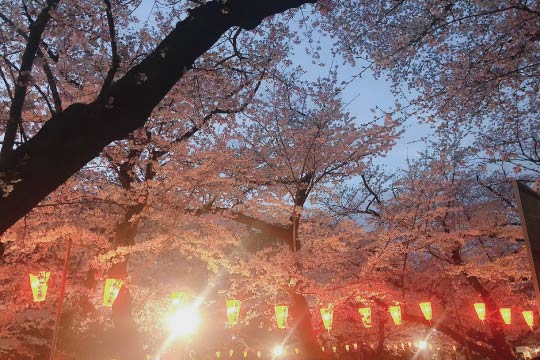
History of Hanami: cherry blossom viewing
It is believed that aristocrats had initiated the flower viewing custom in the Nara period (8th century) to appreciate the plum blossoms introduced from China. Since the cherry blossoms took over the place of plum blossoms in the Heian period (9th century), the aristocrats appreciated the beauty of cherry blossoms while using them as a theme to compose poems and hold banquets.
Farmers, whose lifestyle was far from the aristocrats, had flower viewing events to pray for a good harvest. In Japanese, cherry blossoms are pronounced sakura (さくら). The word "sa (さ)" refers to a deity of rice, while "kura (くら)" indicates where the deity resides. Cherry blossom trees were believed to be the dwelling place of the deity who would come down from the mountains in spring; thus, farmers would wish for the abundance of crops by treating the cherry blossoms as rice flowers and predicting the year’s harvest.
During the Edo period (from the 17th century onward), cherry blossom viewing customs permeated in the general public as same as today. In 1720, the shogun Tokugawa Yoshimune planted cherry trees in Asakusa and Asukayama Hill in Edo (current Tokyo), encouraging the citizens’ outings to enjoy themselves.
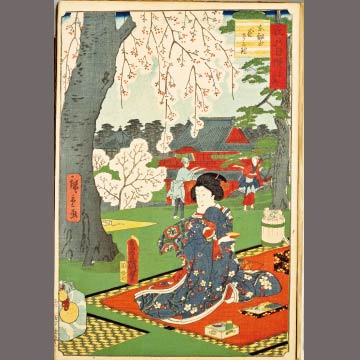
Foods associated with Hanami: "Hanami Bento (花見弁当)", "Sakura Mochi (桜餅)", and "Hanami Dango (花見団子)".
Food is an essential part of Hanami. The bento box prepared for cherry blossom viewing is called hanami bento. In the 9th century, aristocrats ate and drank at elegant banquets appreciating the blooming. Meanwhile, farmers dined with the rice deity residing in the cherry trees while making the offerings of sake and food.
In the Edo period (17th century onward), a bento box with three to four stackable layers and handles was invented, making it conveniently portable for flower viewing picnics. The bento box was made capable of hand-carrying tableware and sake cups in addition to food. Today’s hanami bento is packed with easy-to-eat items, such as rice balls, inari sushi (sushi wrapped in fried tofu), and sandwiches. In the era of social media, bento boxes with colorful, spring-like ingredients such as canola flowers, spring cabbage, and salted cherry blossoms garnishes are often prepared to make them festive and Instagrammable. Those who don’t have a strong suit in cooking can pre-order hanami bento boxes from various restaurants. In addition, supermarkets and department stores offer hanami bento boxes without requiring pre-orders during the flower-viewing season.
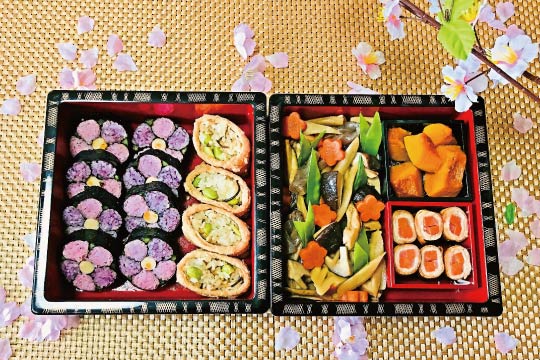
Sweets are also part of the hanami festivity. The Japanese rice cake called Hanami-Dango (花見団子) is three-colored dumplings on a skewer. They are made in a specific color and order: pink, white, and green from the tip of the skewer. Although there are many theories about the origin of the three colors, pink is referred to as cherry blossoms in the sun, white as lingering snow and white sake, and green as mugwort. The color combination creates a scene of warm sunshine melting the snow, prompting green to sprout and cherry blossoms to bloom.
Hanami dumplings come along with a long history since they were served as tea cakes during the Hanami banquet hosted by Toyotomi Hideyoshi, a famous warlord in the 16th century. Colorful dumplings at the hanami banquet spread nationwide and became the general public’s popular food item during the Edo period around the 17th century. The popularity of dumplings during the Edo period is the foundation of the saying "dumplings are better than flowers (花より団子)," which described a mentality valuing substance and practicality over appearance and elegance. The expression is also a metaphor for those who don’t have refined tastes.
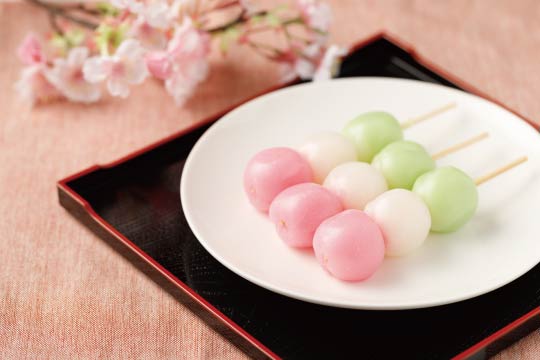
Another Japanese sweet (Wagashi), indispensable during the cherry blossoms season, is Sakura mochi (桜餅). It is a pink mochi filled with red bean paste wrapped in a salted cherry leave.
There are roughly two types of sakura mochi with different wrapping materials between Kanto (the Greater Tokyo region) and Kansai (the Greater Osaka region). The Kanto style is wrapped with a flour-based crepe, also known as “Chomeiji (長命寺),” as it was sold first at Chomeiji Temple in Tokyo. The counterpart in the Kansai region is covered with Domyoji rice flour made out of sun-dried cooked glutinous rice crumbed into coarse particles. Thus, the Kansai style sakura mochi is also known as "Domyoji (道明寺)" as it was created at the Domyoji temple in Osaka.
Some Japanese sweets shops carry both styles, making it fun to compare the tastes. To remind you, don’t remove the salted cherry leave, which provides a cherry blossom flavor and nice saltiness, enhancing the sweetness of the sweet.
What kind of bento and sweets would you make if you were going for Hanami picnics?
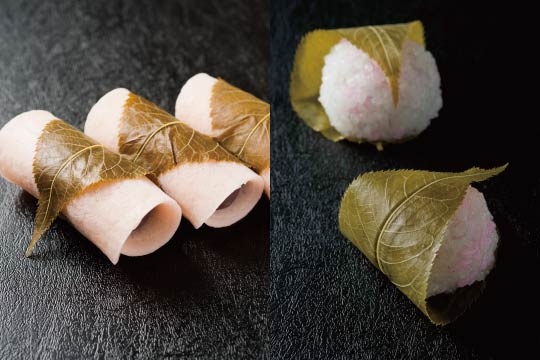
Did you find this blog interesting?
Please share it with your friends in the food service industry.
We regularly update the blog about the food culture of Japan, where TREHA® was discovered for culinary applications.
Click here and send us a message to subscribe.
Or hit us up on Instagram @trehalose_sensei!
You might also be interested in:
Recipe for Mitarashi Dango dumplings - A traditional recipe and a healthy & easy recipe using tofu
Recipe for Kudzukiri with Cherry Blossom
Recipe for Strawberry Mochi Ice Cream Wraps
Japanese traditional food series 2: Chitose Ame, candy for healthy longevity (千歳飴)
Japanese traditional food series 3: Yuzu (柚子) and the winter solstice
Japanese traditional food series 4: Noodles on New Year's Eve (年越しそば)
Japanese traditional food series 5: Japanese traditional New Year’s dishes, Osechi-ryori (おせち料理)
Japanese traditional food series 6: Another traditional food for New Year’s celebration, mochi (餅)
Japanese traditional food series 13: Inari sushi offered to a deity of harvests

